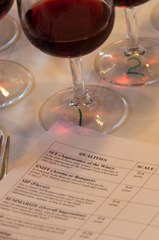Texture: Just as Important as Aroma and Flavor in Wine
By John ~ March 26th, 2010.
 Some people think I’m just a “fruit†guy when it comes to wine. That’s not true, but a grape is a fruit, so a wine that doesn’t exhibit any fruit aromas and flavors just doesn’t seem right to me. Most tastings of wine focus solely on aromas and flavors, because they are a wine’s most striking characteristics. But another important distinguishing feature is not detectable by eyes, nose, or taste buds. That feature is texture.
Some people think I’m just a “fruit†guy when it comes to wine. That’s not true, but a grape is a fruit, so a wine that doesn’t exhibit any fruit aromas and flavors just doesn’t seem right to me. Most tastings of wine focus solely on aromas and flavors, because they are a wine’s most striking characteristics. But another important distinguishing feature is not detectable by eyes, nose, or taste buds. That feature is texture.
Once I determine that a wine has desirable fruit characteristics through aroma and taste, I look for texture, or the way the wine feels in my mouth. Some wine lovers call this “mouthfeel†while others lump it under the term “body.â€
“The idea of texture in a liquid is so difficult, in fact, that wine experts cannot even agree on what to call it. …. [Besides texture, there is] the unwieldy term ‘mouthfeel’ and its constituents: body, density, weight, and for the truly geeky, viscosity. Joshua Wesson, chairman of Best Cellars, a chain of eight wine shops, uses the term ‘umami,’ a Japanese word for the elusive, indescribably delicious quality that goes beyond salty, sweet, sour and bitter.
Whatever you call it, great texture is a crucial though undervalued characteristic of the best wines. It’s a crackling vivacity that insinuates itself in your mouth, almost demanding that you take another sip simply because it feels so good.†–Eric Asimov, New York Times, January 10, 2006
Texture is often described in terms like cushiony, silky, satiny, or velvety. It is especially important to consider in making wine and food pairing decisions. The higher the alcohol and residual sugar levels, the thicker in texture a wine seems. Texture itself is not indicative of a high-quality wine, but it sure doesn’t hurt.
The best wines are well-balanced wines, showing good fruit in harmony with good texture, acidity, and tannins.
Cheers!
Filed under: General Wine Information

 Wine Peeps is an independent wine blog dedicated to helping you get the most bang for your buck in wine. We do this through blind tastings of wine from around the world and calculations of
Wine Peeps is an independent wine blog dedicated to helping you get the most bang for your buck in wine. We do this through blind tastings of wine from around the world and calculations of 











I couldn’t agree more! Great post. I’ve come to believe (erroneously or otherwise) that the real signature of a New World style wine is texture. Big, ripe fruit is part of this, but a great many cellar techniques like micro-ox, cold soaks, post fermentation macerations, new oak, battonnage and so on are aimed at getting the full, coating yet silky mouthfeel New World wine drinkers prefer. Elevated ripeness is more a means to an end; more sugar means more body from alcohol and riper grapes can be more heavily extracted.
I definitely think reviews should focus on structural descriptors–body, tannin, acidity, mouthfeel, red vs. dark fruit, earthy vs. fruity vs. floral vs. funky aromas and so on. There’s not one right way to make wine, and often I’m attracted to edgy or slightly angular wines that have the bite of acid and drying tannin instead of the latte-like texture common in most New World wines. Although texture is not often mentioned, it’s a common theme amongst cult styled wines that they really take texture up several notches.
Thanks for your comment. You make some good points.